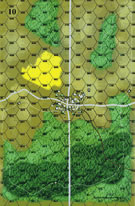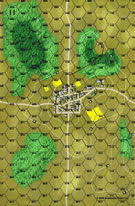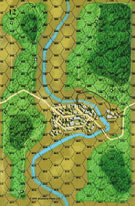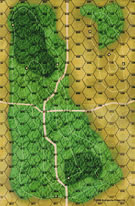|
Wiltz: 18 December Battle of the Bulge #21 |
||
|---|---|---|
| (Attacker) Germany | vs | United States (Defender) |
| Formations Involved | ||
|---|---|---|
| Germany |  |
130th "Lehr" Panzer Division |
| Germany |  |
130th "Lehr" Panzer Reconnaisance Battalion |
| Germany |  |
39th Grenadier Regiment |
| Germany |  |
560th Volksgrenadier Division |
| Germany |  |
902nd "Lehr" Panzergrenadier Regiment |
| United States |  |
28th "Keystone" Infantry Division |
| United States |  |
447th AAA Battalion |
| United States |  |
44th Engineer Battalion |
| United States |  |
630th Tank Destroyer Battalion |
| United States |  |
687th Field Artillery Battalion |
| United States |  |
707th Tank Battalion |

|
| Overall Rating, 8 votes |
|---|
|
2.63
|
| Scenario Rank: 882 of 940 |
| Parent Game | Battle of the Bulge |
|---|---|
| Historicity | Historical |
| Date | 1944-12-18 |
| Start Time | 12:00 |
| Turn Count | 32 |
| Visibility | Day |
| Counters | 153 |
| Net Morale | 0 |
| Net Initiative | 2 |
| Maps | 4: 10, 11, 12, 9 |
| Layout Dimensions | 112 x 43 cm 44 x 17 in |
| Play Bounty | 128 |
| AAR Bounty | 159 |
| Total Plays | 9 |
| Total AARs | 3 |
| Battle Types |
|---|
| Exit the Battle Area |
| Inflict Enemy Casualties |
| River Crossing |
| Urban Assault |
| Conditions |
|---|
| Off-board Artillery |
| Terrain Mods |
| Scenario Requirements & Playability | |
|---|---|
| Battle of the Bulge | Base Game |
| Introduction |
|---|
|
As the American forces opposite the German Fifth Panzer and Eleventh Armies fell back, many naturally moved toward the town of Wiltz, command post of the U.S. 28th Infantry Division. As the front disintegrated, the command post became the front line. |
| Conclusion |
|---|
|
General Cota's decision to hold Wiltz made little sense as the Germans controlled the road net to the north, and with it, access to Bastogne. Immediately to the north Panzer Lehr Division rushed west, but detailed its reconnaissance battalion to drive in the American positions at Erpeldange (Board 11) and Weidingden (Board 10) to prevent an attack on their flank. Once this was accomplished the battalion hung around only long enough to be relieved by the 39th Grenadier Regiment. |
| AFV Rules Pertaining to this Scenario's Order of Battle |
|---|
|
| 5 Errata Items | |
|---|---|

|
The reduced direct fire value of the Heer HMG became 5-5 starting with Fall of France. (plloyd1010
on 2015 Jul 31)
|

|
The morale and combat modifiers of German Sergeant #1614 should be "0", not "8". (Shad
on 2010 Dec 15)
|

|
All SPW 251s have an armor value of 0. (Shad
on 2010 Dec 15)
|

|
This unit is interchangeable with the StuH 42. Technically there never was a StuG IIIh. The StuH 42 was a StuG III with the main armament replaced with a modified 105mm howitzer. The StuG IIIh and StuH 42 counters have the same values, so there is no affect on play. (plloyd1010
on 2015 Jan 30)
|

|
The movement allowance on the counters in Airborne is misprinted. It should be "3." (rerathbun
on 2012 Jan 30)
|
| Wiltz: 18 December |
|---|
|
In this scenario the Americans must repulse a German attack on three towns: Erpeldange, Weidingen and Wiltz. The game is played on 4 boards (from south to north: 12,10,11 and 9). The Germans have elements of 2 divisions (Panzer Lehr and 560th Volksgrenadier). Altogether, 35 platoons of GREN, HMG and ENG, 3 artillery batteries (50 mm and 75 mm), 6 mortars (81 mm), motorcycles, transports (trucks, wagons and SPW 251), 4 tank platoons (PZ IVF2, StuG IIIG and StuG IIIH) and 4 platoons of armored cars (Sdkfz 234/4 and 234/3). They have too a powerful off-board artillery (4 X 16, 2 x 24). The Germans enter by the East of the board of the North end (9). The Americans unfold in 3 remaining boards: 6 units in boards 11 and 10 and the rest in board 12. They cannot move until the Germans have entered board 11. The Americans (elements of several armored and artillery battalions and infantry division 28th) have 18 units of ENG, INF and HMG, 7 artillery batteries (3-inch, 40 mm and 105 mm), 1 mortar (81 mm), 4 tank platoons (M4 - reduced -, M4 -105- and M16), 2 platoons of armored cars (M8) and some trucks. They do not have off-board artillery. Win the player that obtained more victory points. Score the enemy casualties, the German units that exit the west edge of board 9 before certain hour and the towns that remain completely in American hands at the end of the game. The Americans unfold first. They put all his armored forces in board 11, along with some leaders as artillery observers. The platoon of M16 is in the edge of board 11, to cover with his Direct Fire a road hex in board 9. The Americans locate their heavy artillery (3 batteries of 105 mm) in the town of board 10 (Weidingen). The rest of their forces is located in board 12, in the environs of Wiltz. The scenario lasts 32 turns (it begins at 1200). The Germans begin to enter by the East of board 9 with orders to exit as rapidly as possible the west edge. SPW 251 transport by road units of infantry from an edge to another of the board. Some quick platoons of motorcycles are able to exit the west edge as well. American heavy artillery beats the road causing some losses. The platoon of M16 makes a powerful Opportunity Fire in the road hex and inflict losses to the Germans as well. Some German units that cannot be transported in SPW 251 move slowly towards the west, covering itself as far as possible in the woods. The powerful German off-board artillery cannot respond, since the Americans are perfectly camouflaged or outside the reach of the artillery observers. Until the 1400 the Germans are able to exit 12 units by the west edge (GREN, HMG, ENG and motorcycles). In the meantime, German armored units had penetrated in board 9 and had been placed to attack the American tanks and armored cars located in the town of the board 11 (Erpeldange) and its environs. A ferocious combat break out between the armored forces of both sides. The Americans have unfolded their units to certain distance each other, in the town, the heights and some dug in. They look for the the crossfire bonus. The Germans, more numerous, with better shield and firepower, attack in groups. After little more than one hour of intense cannonade and fast movements, the Americans lose all their armored units. The Germans lose a platoon of StuG IIIG, another one of Sdkfz 243/3 and one step of StuG IIIH. In the course of the tank battle, the Germans enter board 11, and the Americans can finally move. The Americans transfer by road in trucks to Erpeldange 3 batteries of 3-inch and 1 of 40 mm. The town appears now spiny of anti-tank guns. This brake the armored German advance, but it starts the movement of the division Panzer Lehr infantry to assault the town and to neutralize the antitank batteries. The approach of the infantry, that has to move in discovered field, is prevented by the American heavy artillery, that arouse some losses. The American main forces begins to concentrate in board 10 (in or next to Weideingen), to go at full speed by road in trucks to Erpeldange. This movement is anticipated by the Germans, who send part of their armored forces (2 platoons of Pz IVF2 and 3 of SPW 251) to intercept the road between Weidingen and Erpeldange. The march of tanks and SPW 251 is by the margin of the board, to avoid the lethal anti-tank guns of Erpeldange. Some trucks with American infantry arrive at this town and prepare to resist the imminent German assault. Other trucks, nevertheless, do not have as much luck and undergo long distance anti-tank fire from the Pz IVF2. Some trucks and the platoon they transport are destroyed; the rest disperses in all directions. The Germans are on the verge of cutting the vital American artery of communication! The American commander does not lose the calm. He orders that a battery of 105 mm is transferred to another hex of Weidingen, to obtain the crossfire bonus when the German tanks are near. He orders in addition that another battery of 105 mm moves to the board 12 town (Wiltz), that is almost unguarded. In the meantime, in the board 11 Germans already are closely together at Erpeldange and undergo the American Direct Fire, but the German artillery observers are now able to see the American locations of artillery. A fire deluge falls on the American positions. A battery of 3-inch is destroyed and some units of infantry are disrupted. The German assault is imminent. At 1500 units of the 560th Volksgrenadier Division enter the East edge of board 9. At the same time, the fire of the German off-board artillery decreases, since the the ammunition begin to be in short supply. In addition, their units of infantry continue suffering losses before the American mortar and HMG fire. At this moment (1530), the Americans are losing the game (Germans: 45 Victory Points; Americans: 16 VP). The Americans need to conserve complete the 3 towns if they want to gain the game. American AT cannons are frightful. A group of SPW 251 marched by the East of the board believing to be at safe distance. Nevertheless, a battery of 3-inch destroys one of them with Opportunity Fire. Almost at the same time (Opp. Fire as well), an 40 mm antiaircraft battery destroys another one. Luckyly for the Germans they were empty. In a later turn, a battery of 3-inch destroys 1 step of a platoon of StuG IIIG, that believed it was at safe distance. At 1600 two platoons of PzIVF2 cut the road between Weidingen and Erpeldangen. The American forces have been divided in two. They will be isolated all the game. Now the Germans will be able to attack each group separately. After it, the first assaults take place on Erpeldangen. German infantry attacks hexes north of the city. The Germans are more, but the combats are very balanced, since many American units are ENG and have bonus in urban assaults. Nevertheless, after more than one hour of combats without decisive result, the Germans are able to coordinate a combined group of assault with 1 tank platoon (reduced), 1 ENG and 1 GREN, supported by leaders with combat and morale modifiers. Now everything changes. The Germans have started a "road roller" that advances north-south and expels slowly the American forces. The German assault group undergoes losses as well, but they are replaced quickly with adjacent platoons. The assault is synchronized with the German off-board artillery, that previously crushes the hex that is going to be assaulted. Everything works like clockwork, but soon the German artillery stops. The ammunition is finished. Quickly the Germans form a great mortar battery (4 units), that returns to beat the American hexes that still resist. In the other side, the American heavy artillery, still intact, continues bombing very insistently the hexes invaded by the Germans and the units that approach the town. The fire in the town (Friendly Fire) produces losses (1 American unit destroyed and some disrupted). The American artillery also shoot counterbattery fire against mortars. Some are disrupted or demoralized. The Americans in Weidingen are inactive, for that reason the 2 platoons of Pz IVF2 in the road now attack the south of Elperdange. They are supported by 1 SPW 251 and 1 GREN. At 1845 the German attack has occupied the center and the south of the town. The battered American forces resist as they can isolated in 2 hexes. Erpeldange is a smoky ruin. The German armored units go now towards Weidingen, protected by the increasing dark. Great part of the German infantry continue in Erpeldange cleaning the last pockets of resistance. The German tanks and armored cars approach Weidingen by the west, the side nonprotected by the American artillery. Taking advantage of a negligence and the almost total dark, a StuG IIIG is able to infiltrate in a hex of the town. Then (2000) the game finishes. Result: German victory. Victory Points: Germany 68, US 43. Losses (steps): Germany 25, US 38 (Tanks count double). Duration of the game: 9-10 hours. (Solo play). Tense and fun game. (I apologize for my poor english). |
| 0 Comments |
| Another German Cakewalk |
|---|
|
German artillery and troop numbers overwhelm Americans. Game was too long to model a "delaying action". VPs rewards US by holding EVERY hex of a town. A nearly impossible task. VPs should have been written to encourage US to conserve and congregate troops in lieu of trying to hold onto everything. How does the axiom go? "He who tries to control everything controls nothing." On to #22. |
| 0 Comments |
| Battle of the Bulge #21 | ||||||||||||
|---|---|---|---|---|---|---|---|---|---|---|---|---|
The Germans can score enough points to win the game by marching across map 9 out of sight of the Americans and denying battle. The Americans can only be awaken if the Germans move south. Without a reason to do so, they will not. Additionally, even if they chose to attack the Americans just because, the American VC's are very poorly written, requiring control of every town hex on a given map to gain points (aside from points for killing Germans). Unfortunately this is another scenario that feels like it never saw a playtest table prior to publishing. It simply broken. The Germans walk across the map unopposed while the Americans cannot move. This is the second time so far this has happened with BotB scenarios. |
||||||||||||
| 0 Comments |

 BaBu020
BaBu020 








































